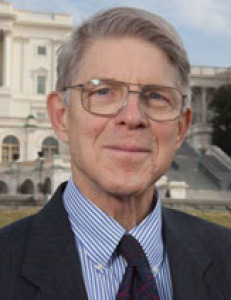WASHINGTON, Oct. 4, 2017 – “Since it is not a question of ‘if’ but a question of ‘when’ the power grid will face significant physical and cyber threats, resiliency should be a priority for our electricity system.”
That’s what House Science Committee Chair Lamar Smith, R-Texas, warned in opening his Resiliency: The Electric Grid’s Only Hope hearing Tuesday. He said that as demonstrated by Hurricane Harvey, “we don’t know when the next devastating natural disaster will occur.”
To deal with the proliferation of threats to the grid that include intensifying hurricanes, droughts, flooding, ice storms, human error, malicious cyberattacks, and the potential of crippling electromagnetic pulses, Smith said that “instead of simply focusing on threats, we should prioritize improving the resilience of our electric grid.”

Rep. Lamar Smith, R-Texas
To help identify the best strategy for improving the grid, Congress tasked the National Academies of Sciences with studying the problem. In response, the NAS delivered its 171-page report, Enhancing the Resilience of the Nation’s Electricity System, in July.
“Because no single entity is in charge of planning the evolution of the grid,” the report warned, “there is a risk that society may not adequately anticipate and address many elements of grid reliability and resilience.” Furthermore, it said “the risks of this system-wide failure in preparedness will grow as the structure of the power industry becomes more atomized and complex.”
Smith agreed Tuesday, saying “we often ignore the fact that damage to the power grid can and will continue to occur.”
NAS report’s detailed recommendations include “more regional emergency preparedness exercises,” greater coordination among the multiple government and private entities responsible for grid operations, stockpiling replacement transformers, and funding research “on enhanced power system wide-area monitoring and control and the application of artificial intelligence to the power system.”
Questioned by Smith, Williams Sanders, one of the NAS report’s authors, said the good news is that “substantial progress has been made” on both day-to-day grid reliability and longer-term resilience.
Sanders, head of the Department of Electrical and Computer Engineering at the University of Illinois, explained that over the past 20 years, the Department of Energy, its National Labs, the National Science Foundation and others have developed a range of technical solutions to protect the grid. He said today’s challenge is to reach agreement and provide the funding “to implement those solutions.”
Another witness, Gavin Dillingham, program director for Clean Energy Policy at the Houston Advanced Research Center, added another challenge: cost. He pointed out that a suggestion by Rep. Charlie Crist, a Democrat who formerly was a Republican governor of Florida, that more transmission lines be buried, would be costly in the short term.
Dillingham also explained that as with many options being considered, the multiple threats to the electric grid can make it very difficult to pick the best strategies. Burying power lines prevents damage to overhead transmission lines from high winds and ice storms, he said, but can make them more vulnerable to being disabled by flooding.
Walt Baum, executive director of the Texas Public Power Association testified to threats from flooding. He explained that after a half century of operating with no water problems, the major Houston Memorial substation “was flooded and under water for over 10 days” when Hurricane Harvey hit. In response, he said the substation is “being rebuilt with the new normal,” to raise it above even greater flooding from anticipated future storms.
Rep. Randy Weber, R-Texas, noted that his Beaumont district was “Ground zero for Harvey flooding” and that Beaumont needs to raise its electricity system “6 to 8 feet” to prepare for future storms. He also called for a concerted national effort to train personnel and deploy portable emergency equipment to provide for faster recovery from any grid problems.
Dillingham and Rep. Jerry McNerney, D-Calif., agreed on another solution already in use around the country: microgrids with distributed energy like solar and wind power generation. They pointed out that these “islanded” facilities can be used to restore power quickly for limited areas and for key facilities including hospitals, communications, and water systems.
But Dillingham warned that because the U.S. faces increasing climate-change risks, the need to invest in new protective infrastructure “when you are financially limited as we are” creates tough choices. Should a government agency or a utility invest in protecting against flooding or against drought? Both may be potential threats, particularly in Texas and similar areas, but the two threats call for different solutions, each of which may be high cost.
At least according to McNerney and Dillingham, one catch-all response could be self-sufficient microgrids with enough wind, solar and battery power to eliminate depending on fuel supplies or on transmission lines.
Rep. Mark Takano, D-Calif., raised a related contentious issue: coal.

Energy Secretary Rick Perry
Last Friday, Energy Secretary Rick Perry directed the Federal Energy Regulatory Commission (FERC) to “Issue Grid Resiliency Rules” to provide additional support for “traditional baseload generation with on-site fuel storage that can withstand major fuel supply disruptions caused by natural and man-made disasters.” Perry’s directive to the FERC charged that additional support for coal and nuclear power generation is needed because “the resiliency of the electric grid is threatened by the premature retirements of these fuel-secure traditional baseload resources.”
Takano’s response Tuesday to Perry’s directive was that “even conservative experts” reject Perry’s contention that current FERC rules “have resulted in under-valuation of grid reliability and resiliency benefits provided by traditional baseload resources, such as coal and nuclear.”
At Tuesday’s hearing, Texas Public Power Association Executive Director Walt Baum said that with today’s multiple fuel sources, “I don’t think any special subsidy is needed” for coal or nuclear.
# 30
For more news, go to www.Agri-Pulse.com


